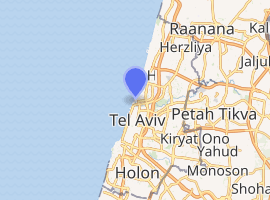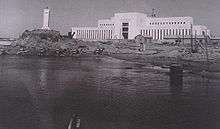Reading Light
Reading Light (Hebrew: מגדלור רדינג), also known as Tell Qudadi Light (sometimes spelled Tel Kudadi Light), HaYarkon Light, Auja Light and Tel Aviv Light, is an inactive lighthouse in Tel Aviv, Israel. It is located near the beach on the north side of the Yarkon River estuary, on the foot of the Tel Aviv south breakwater, next to the Tel Aviv Port and the Levant Fair buildings area. It takes its name from the Reading Power Station.
 Reading Light in 2013 | |
 | |

| |
| Location | Tel Aviv, Israel |
|---|---|
| Coordinates | 32°6′12.86″N 34°46′37.11″E |
| Year first constructed | 1934 |
| Year first lit | 1935 |
| Deactivated | 1965 |
| Foundation | cylindrical stone basement |
| Construction | concrete tower |
| Tower shape | square tower, lantern removed |
| Markings / pattern | formerly: black and white checkerboard now: concrete |
| Tower height | 17 metres (56 ft) |
| Characteristic | Morse "A", two flashes, one long and one short, every 7s[1] |
| Admiralty number | E5958 (former) |
| Heritage | Heritage site in Israel |
The lighthouse played a role in several Israel films, such as Late Summer Blues, and appeared on an Israeli stamp issued 26 November 2009.[1]
History
The lighthouse was built by the British authorities in 1934–1935 to help ships approaching the shore pass local sandbars safely.[1] The company performing the construction was a French company, assisted by Arab locals.[2]
During its construction, a tell was found, and was named Tell Qudadi. The tell was excavated in 1936–1938 and remains of two Assyrian fortresses from the 8th century BCE were discovered.
On 19 April 1936 the Arab revolt broke out and a general strike began, crippling the Jaffa port and threatening to stop the citrus fruit export. Initially against the wishes of the British authorities, the Jewish establishment decided to open Tel Aviv port as a competing port to Jaffa. The location chosen was at the Yarkon River estuary, close to the lighthouse, and the lighthouse served as a navigation aid for the port.
Between 1937 and 1938 the Reading Power Station was built nearby.[3] Its tall lighted chimney made the lighthouse somewhat redundant and also obscured the light through a sector. However, the light continued to work, serving the adjacent electricity plant harbor as well.
In 1965, when the port was officially closed due to the opening of the Ashdod Port in the south, the light was shut down.
In 2007 the Israeli Antiquities Authority built a wooden boardwalk around the tell and the lighthouse, which makes it now easily accessible to the public, though the tower itself is closed and all the windows barred.
The lighthouse was formerly painted in a black and white checkerboard pattern, and traces of the paint remain.
References
- "Lighthouses in Israel". Philately News. Archived from the original on 2011-05-06. Retrieved 2010-07-19.
- "חופי הכרך תל אביב יפו" [On the waterfront Tel-Aviv Jaffa]. shezaf.net. Retrieved 27 July 2010. Abu Musa describes in this text how his grandfather, who was the owner of the Beirut lighthouse, was called by the French company to assist in the construction.
- Mordechai Naor (2003). ברכת החשמל [The Blessing of Electricity]. Yad Yitshak Ben Zvi.
- Rowlett, Russ. "Lighthouses of Israel". The Lighthouse Directory. University of North Carolina at Chapel Hill. Retrieved 2010-07-19.
| Wikimedia Commons has media related to Reading Lighthouse. |
